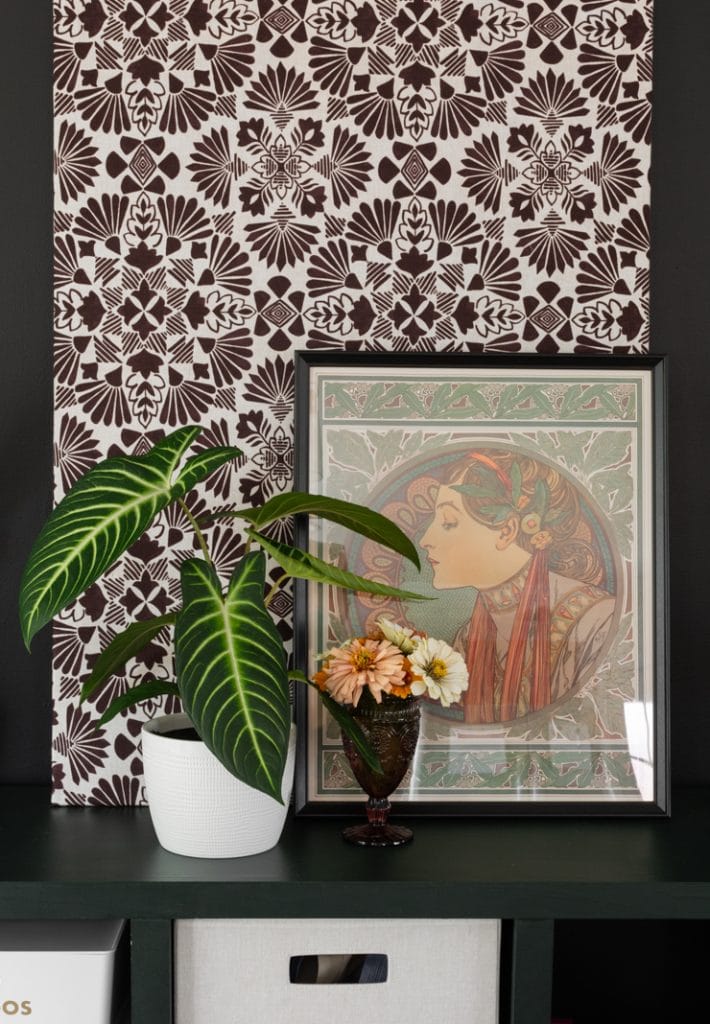Xanthosoma lindenii is a tropical plant with striking green and white arrowhead-like leaves. Learn how to help this plant thrive indoors, including how much light it needs, when to water it, how much humidity it likes, and more.
My xanthosoma lindenii care guide!
Xanthosoma lindenii is a striking plant that reminds me a lot of the alocasia polly—a type of elephant ear. I’d say that xanthosoma lindenii has one foot in the elephant ear world and one foot out of it.
Why? Because botanists have reclassified it many times over the years. You might see it labeled xanthosoma lindenii, caladium lindenii, or phyllotaenium lindenii. And caladiums are generally considered to be a type of elephant ear.

What is a xanthosoma lindenii?
Xanthosoma lindenii is a tropical plant from Colombia and other nearby tropical areas. Its arrowhead-like green leaves have hues of turquoise in some lighting, which is contrasted by white veining.
The stems (also known as petioles) also have brown hair-like growths all along them. This is similar to the philodendron fuzzy petiole’s hairy stems. It’s totally natural and is nothing to be concerned about.
I often see this plant referred to as “rare,” but I don’t think anything that is being grown by one of the largest growers in America is “rare.” It’s pretty easy to find these days, but I still consider it an interesting addition to any plant collection!


How much light does a xanthosoma lindenii need?
As a tropical plant, xanthosoma lindenii has evolved to grow in bright conditions. But it grows on the ground under other trees, meaning it is often protected from too much direct sun.
This is good news for lindenii as a houseplant because it means the plant does best in bright, indirect light. Don’t worry about putting it in your brightest spot. Too much direct sun can actually burn xanthosoma lindenii’s leaves.
The plant can also withstand medium light levels, but keep an eye on it to make sure it isn’t stretching to one side to reach a light source. You may need to rotate the plant to help ensure even growth. Or add some sort of grow light, which lindenii will respond well to.
When I first got my plant, I put it under the gazebo on our patio. This area gets very little direct sun at all, but it gets a lot of indirect light. So was the perfect summertime spot.

Want more? Check out my post about Alocasia Regal Shield Care and my Snake Plant Care Guide!
What type of soil is best?
Any sort of high-quality well-draining houseplant soil mix will do just fine. Make sure your soil isn’t too dense—things like perlite, coco coir (a great peat moss alternative), vermiculite, or orchid bark are all things that can help encourage drainage and lightweight moisture retention.
If your soil is too dense, oxygen will not be able to get to the plant’s roots. It’s a quick way to kill the plant—so avoid that!

How much water does a xanthosoma lindenii need?
If you have your xanthosoma in a well-draining soil mix that encourages lightweight moisture retention, you’ll want to water your plant when the top several inches of soil are dry. You can just stick your finger in to check.
For my growing conditions, this is generally once every 5-7 days in the summer—much less in the winter. In the spring and fall, it depends on the amount of light and temperature. That’s why it’s always best to check the soil.
If you don’t let the top few inches of soil dry out before watering the plant again, the plant’s roots will begin to rot. Also, when you water the plant, make sure you let all of the water drain completely out of the pot’s drainage holes.
I also like to water my plants in the kitchen sink or bathtub. That way I can rinse the leaves off to clean them—much easier than wiping them off by hand.

Temperature & humidity
Average household temperatures are fine for xanthosoma lindenii. Shoot for something in the 70s or 80s Fahrenheit. The plant’s growth will slow way down in cooler temperatures. And it is definitely not cold or frost hardy—it will die.
In the fall and winter, try to keep the plant away from doors or drafty windows. Cold gusts and drafts can definitely stress lindenii out.
As far as moisture in the air goes, xanthosoma lindenii is definitely a higher humidity lover. I recommend adding a room humidifier near the plant and grouping it with other plants. This will help keep the ambient humidity levels higher.
If you don’t add any extra moisture to the air, the plant might begin showing signs of stress. For example, crispy brown tips on the leaves or dry spots.

Growth rate, pruning, & repotting
Xanthosoma lindenii is a relatively slow grower, even in ideal conditions. However, it can grow to be several feet tall. And a single leaf can be over a foot long. Even as a more juvenile plant, its leaves are quite impressive.
You won’t need to repot this plant frequently. I recommend waiting until the roots begin growing out of the pot’s drainage holes. Repot it using fresh soil, and size the pot up only about an inch or so.
And it doesn’t require much pruning at all. You can trim off the older, smaller leaves as they fade—or if you just want the plant to focus on newer, larger growth.

Fertilizer needs
You can help to encourage healthy new growth by fertilizing your xanthosoma with a balanced fertilizer designed for houseplants. Follow the instructions on the packaging carefully to avoid burning your plant.
I like to use a fertilizer like Foxfarm Grow Big or Liqui-Dirt concentrated plant food. You only have to add a tiny bit to your watering can, so it lasts a long time. You also only need to fertilize in the spring and summer—so don’t waste that stuff in the fall and winter!

Is xanthosoma lindenii safe to have around pets?
I had a hard time finding specific information about xanthosoma lindenii’s toxicity—but it appears to be mildly toxic. Regardless of its toxicity, I always recommend keeping houseplants away from pets and kids.
That’s because they aren’t meant to be ingested. They are just for ornamental use. Some non-toxic plants I’ve had to rehome because my cat can’t resist munching them and throwing them up.

How do you propagate a xanthosoma lindenii
Xanthosoma lindenii reproduces by growing tubers under the soil. These tubers multiply and spread, sprouting new stems and leaves.
You can propagate the plant by dividing the tubers. I have not done this to my lindenii yet, but the process is very similar to propagating an alocasia plant.
Simply cut or break a tuber off and replant it separately in a smaller pot. I recommend waiting a day or two to water so the cut part of the tuber can callus over. But I don’t always do that…and it’s usually fine 🙂
Pin my Xanthosoma Lindenii care guide!


Brittany is a seasoned DIY home and garden expert, running a creative brand since 2014 that inspires others with approachable plant care guides, woodworking tutorials, and decor projects. She is a certified project manager and has completed extensive coursework in the art and science of growing your own plants. Her work has been recognized by major publications, and she routinely collaborates with fellow DIY industry leaders—but her favorite thing to do is inspire you! Learn more about her here.

I found white mites or pods on the underside of my leaves? How do I take care of that?
I would first try to identify what it is with pictures, then rinse the plant’s leaves off to get the mites/pods off. Then I would spray with something like Captain Jack’s Dead Bug Brew, making sure to get the undersides of the leaves too!
exelente informacion,apenas adquirí y es hermosa, en base a esta valiosa información tendrá sus cuidados necesarios
Gracias <3
My zanthosoma is turning brown. I don’t want to lose it. Should I snip off the brown leaves only or cut it down to the dirt? Thank you!
Yes, I would snip off the brown leaves as a first try. If the other leaves start browning too, you can cut them all down.